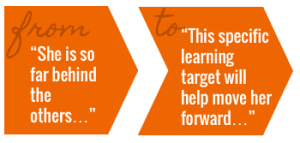CompetencyWorks Releases New Report, Meeting Students Where They Are
Education Domain Blog
Competency-based education has reached an exciting moment in its evolution. In the last 10 years, we’ve witnessed great progress in state policymaking, and states, districts and schools have taken on the challenge of creating new school models, designing original competency sets and reorienting assessment strategies. At the core of these efforts is a belief that for students to succeed, we must design learning experiences that meet them where they are.
iNACOL’s CompetencyWorks initiative today released Meeting Students Where They Are, a report that explores how competency-based education can be designed to meet the needs of all students. To meet students where they are means to change the way we relate to them in profound ways — cognitively, culturally, physically, academically, linguistically and emotionally. Our work is to “reconfigure our old systems, practices and paradigms” and place the individual learner at the center of the learning process.
Competency-based education models are organized to meet students where they are in terms of academic, cognitive and lifelong learning skills (growth mindset, habits of work and learning, metacognition and social and emotional skills). In contrast, traditional education systems use a one-size-fits-all grade-level content delivery model that is based on age, rather than their appropriate zone of proximal development. This results in gaps in learning and unmet needs.
The new paper uses three central questions to explore the relational, pedagogical and structural dimensions of meeting students where they are:
- How do we know where students are? We unpack this question by first addressing its underlying assumptions. Where students are. In relation to what exactly? With younger students, we tend to look at gross and fine motor skill development, social-emotional development and literacy and numeracy development. As students move into late childhood — eight or nine years of age — most systems transition to content exploration, while continuing to support skill development. By the time students are approaching adolescence, the system’s priority is broad content coverage, which shortchanges students’ ability to go deep, develop skills and gain conceptual understanding.
- What do we do, once we know? Learning is a co-constructed process, in which students are in the driver’s seat navigating toward meaningful and important outcomes. The only way to truly meet students where they are is for competency-based models to adopt a personalized approach to learning: an approach that accounts for students’ differing zones of proximal development with regards to specific cognitive skills, as well as within the physical, emotional, metacognitive and other domains. The paper offers a prototypical framework that is designed to help practitioners operationalize a personalized approach in the academic realm.
- Which strategies help us navigate systemic constraints? Meeting students where they are is ultimately a structural challenge. It requires re-imagining and redesigning school models around the needs of the individual, rather than the efficiency of the system. There is something of an accountability paradox at play in our educational system: the very accountability system that led to much greater transparency about the performance of the education system and its inequity is also holding the traditional system that perpetuates inequity in place.
The development of second-generation competency-based education models provides the opportunity to anchor student learning and achievement in expansive, adaptable and developmentally appropriate learning and development trajectories informed by the learning sciences. If we are to meet all students where they are, then our commitment must be not only to an uncompromising vision for high achievement — college and career readiness — but also to the daily work of responding to students’ individual needs in a way that fosters optimal growth.
Meeting Students Where They Are provides educators with access to current research, new paradigms and emerging best practices. In addition, the paper discusses the implications for systemic changes that must be addressed if we are to transform the system from one of sorting and labeling to one where deep learning and discovery are available to all students.
Download the full report, Meeting Students Where They Are.
For more information:
- iNACOL – Quality and Equity by Design: Charting the Course for the Next Phase of Competency-Based Education
- iNACOL – What Does It Mean to Meet Students Where They Are?
- Harvard University Press – Readings on the Development of Children
- CAST – Universal Design for Learning
- National Association of School Psychologists – Adolescent Trust in Teachers: Implications for Behavior in the High School Classroom
- JSTOR – Funds of Knowledge for Teaching: Using a Qualitative Approach to Connect Homes and Classrooms
- For more resources and recommended reading, visit CompetencyWorks
- Follow CompetencyWorks and iNACOL on Twitter: @CompetencyWorks, @nacol

